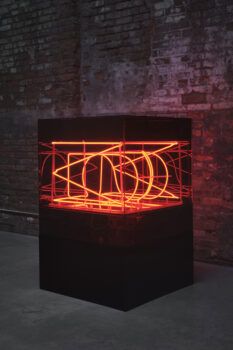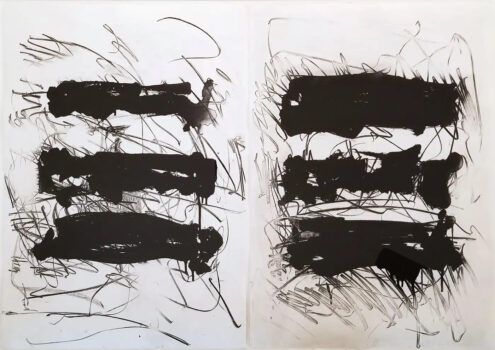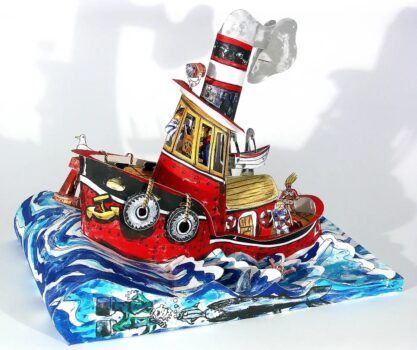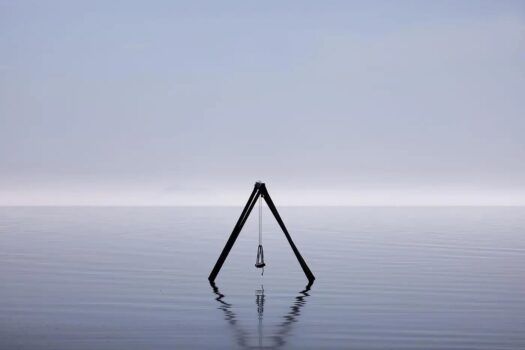
Certain objects can magically transform a room — they anchor a space, alter perspectives and serve as visual cues that draw the gaze, subtly shaping how we experience our surroundings. They also serve as time capsules — silent keepers of memory and meaning, carrying traces of the past and telling stories that enrich the present.
As a child growing up in a redbrick Edwardian house near the zoo in Central London, I was transfixed by a lamp in the corner of what my parents christened the Best Room. It cast a warm magenta glow, and twin tigers appeared to pace stealthily across the bottom of its fan-shaped glass shade, as if weaving their way through the pages of a storybook.
The Best Room was strictly reserved for grown-ups, accessible to my brother and me only if accompanied by a parent. It was a shrine to my father’s prized glass collection, many of whose pieces hailed from the Art Deco era. The tiger lamp, designed in the 1920s by French glass artist Gabriel Argy-Rousseau and composed of a translucent vertical shade on a boxy wrought-iron base, was his pride and joy, displayed high on a ledge, safely out of reach.
Our bohemian home was full of eccentricities: a mix of flea-market bric-a-brac, Georgian furniture, contemporary prints by artists like Allen Jones and landscape oils by little-known Ukrainian modernists. My father, a professor of biochemistry and an avid treasure hunter, owned a G Plan Librenza room divider best described as an ungainly bookcase, filled with dog-eared paperbacks. He also had a marble bowl with a dented bronze bear perched on the rim, a gift from his father, which he used as a vide-poche.

Suffice to say that, although my parents weren’t precious about most things, the glassware was strictly off-limits and especially the Argy-Rousseau, which he’d acquired at auction.
It was a near-mythical presence in our home. My father described it in words I didn’t understand — and nor did he explain them, knowing, perhaps, that doing so would diminish the piece’s mystique. It was made of something called pâte de verre, he said, its multicolored reliefs the result of pure “alchemy.”
At the time, he didn’t share that pâte de verre was made by grinding glass into a powder and mixing it with a binding agent like gum arabic to create a moldable paste. However, he once revealed that the lamp appealed to his scientific mind because Argy-Rousseau worked with pigments with the precision of a chemist. My father’s area of specialization was carotenoids, natural pigments responsible for the yellow, orange, red and purple colors of many plants and animals, including lobsters.
I now understand the connection, but as a seven-year-old, I didn’t know what all of this meant. I didn’t need to. I was mesmerized by that object more than any other — not just for its glow or its charming tigers but also for the sense of wonder it conveyed, like a secret family jewel.
Since then, I’ve learned that Argy-Rousseau was widely recognized as a master of invention during his lifetime. Born in 1885 as Joseph-Gabriel Rousseau (he later added the first part of his wife’s maiden name, Argyriades), he studied at the École supérieure de céramique, in Sèvres, and was greatly influenced by the work of pâte de verre pioneer Henri Cros. Adapting a technique that dates back to the ancient Greeks and Romans, Argy-Rousseau brought the medium to new artistic heights.

Using glass powders and pigments derived from metal oxides, he carefully applied his colored glass paste to handcrafted ceramic molds. By building up layers of varying colors and thicknesses, he created intricate patterns and motifs that were fused together at high temperatures in a kiln.
His lustrous, almost opalesque designs reflected the decorative tastes of the time, featuring insects, butterflies, Grecian nudes and exotic animals — all subjects that resonated with the era’s Art Nouveau and Art Deco sensibilities.
To find out more about my father’s much cherished tiger lamp, displayed atop my own bookcase since his death, I turned to Ben Macklowe, of New York’s Macklowe Gallery, which is offering its twin on 1stDibs.
“We know of at least three examples of this lamp, two of which were documented in the [1991] Argy-Rousseau book by Janine Bloch-Dermant,” says Macklowe, who adds that the tigers were directly influenced by ancient Persian lion relief panels exhibited at the Louvre since 1909. These impacted many fin-de-siècle creators, including the famous painter Henri Rousseau, who shared Argy-Rousseau’s affinity for big cats in addition to sharing his family name (although the two aren’t known to be related).
“It is almost the night-light version of a Henri Rousseau painting in subject matter and stylization,” says Macklowe, pointing to its parallels with that artist’s jungle series, especially his 1891 canvas Surprised!, also known as Tiger in a Tropical Storm, which depicts the cat crouching in tall grass, ready to pounce on its prey.

Argy-Rousseau’s tigers are less menacing and more serene, although one does appear to be growling, perhaps in protection of its companion.
Another interesting point of difference is the vegetation, not green and leafy but angular, mauve in color and cast in the shape of an asymmetrical ribbed fan. Created three decades after Rousseau’s painting, this abstracted rendition of a jungle landscape was, according to Macklowe, guided by the industrial advances of the Machine Age, specifically the construction of the first skyscrapers. Were Argy-Rousseau alive today, the gallerist would quiz him further on this point. “I would ask him what he felt the role of the aesthetics of the past was in his rapidly changing world,” says Macklowe, “and how he felt about the role of beauty in the modern city.”
A prolific craftsman, Argy-Rousseau produced between 15,000 and 20,000 pâte de verre pieces in his lifetime, including a series of jewelry pendants. Pristine examples of functional treasures like the tiger lamp, however, are exceedingly rare and much coveted. Indeed, many of his creations now reside in elite settings, says Macklowe — among them, the homes of “several high-profile clients of ours, including actors, musicians and famous founders.”
For Macklowe, the appeal of the lamp lies in its subtle ability to engage the eye and hold our attention. “This is a beautiful example of complementary colors,” he says. “They’re so striking and read quite beautifully from afar.”
My lamp, though, rests within arm’s reach, in a more minimalist room than before, made exceptional by its presence.





